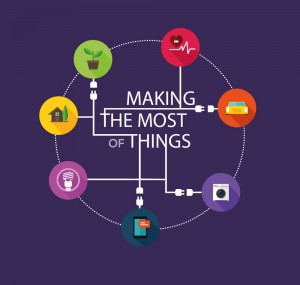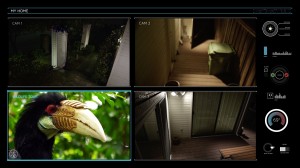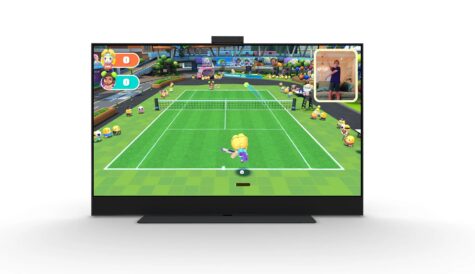Making the most of the Internet of Things
 With the Internet of Things ultimately expected to be worth up to US$7 trillion, operators need to invest now to remain relevant, reports Adrian Pennington.
With the Internet of Things ultimately expected to be worth up to US$7 trillion, operators need to invest now to remain relevant, reports Adrian Pennington.
The concept of the Internet of Things (IoT), or a truly interconnected world, where every device and system is smart and can communicate with other devices and systems without human intervention, has been in development for a number of years and is already present in some industries. Analyst group IDC has somewhat wildly forecast the IoT to be worth over US$7 trillion (€6.6 trillion) by 2020.
The entertainment business is arguably the first sector to push an IoT digital ecosystem closer to consumers in the areas of wearable technology, smart homes and smart cities. While the context today is narrow, the combination of these devices with information gleaned from sensors in cars, thermostats, lighting, or doorbell opens a myriad of possibilities.
“For instance, with wearable technology we can finally understand who an audience is and use the combination of their presence, plus other environmental indicators that the devices are communicating, to give content recommendations,” says Charles Dawes, senior director, product marketing at TV technology provider Rovi. “Other simple examples are already possible, such as controlling your connected lights so the ambience of your living room matches the mood of the film you’re watching.”
To capitalise on the IoT opportunity, the world needs there to be a base level of ubiquitous connectivity ensuring that devices are able to communicate no matter where they are. Assuming this infrastructure is in place, then the opportunity is one of building products and services on top “so that consumers can be provided with more personalised, targeted and value-added services than ever before,” says Dawes.
For Dawes, telecom and cable service providers are among the players best placed to deliver the applications that the IoT could unleash.
“Service providers have the opportunity to move outside of the areas they’ve been traditionally bound to. For instance, as smart metering and the connected home takes off, the service provider can build new services around it that integrate the existing voice, data and video solutions with new ways to grow their business,” he says.
Google competition
While the opportunities are there, MSOs and other service providers will face stiff competition from internet and consumer electronics giants in targeting the IoT market.
First among these are the big internet players. Through its connected home division Next, Google has acquired Revolv (a hardware hub packed with radios for syncing various smart home devices with each other) and security camera company, Dropcam. These will be linked to the Android operating system by Google.
Google’s rival Apple is making a similar play with its Apple TV, iWatch and iPhone devices, linked to IoT platform HomeKit. Even Facebook is getting in on the act. Its acquisition in January of voice-recognition start-up Wit.Ai is considered to be the social network’s first major foray into the IoT world. Consumer electronics giant Samsung meanwhile spent US$200 million in August last year on SmartThings, a Washington DC-based start-up which allows people to synchronise connected gadgets using a single smartphone app and hardware hub.
While the internet giants have the resources to make the IoT their own, and Google et al are spending billions of dollars to acquire entry points into the home, cable operators and telcos, and to some extent consumer electronics companies, have the immeasurable advantage of already being there. They’ve amortised investment in remote controls and set-top boxes and are now extending their reach with other devices, such as dongles and WiFi extenders, via multi-service residential gateways. What’s more, with their golden asset – their existing, trusted, billing relationships with customers – they are better placed than Apple or Samsung to deliver many of these additional services into the home. Nevertheless, capitalising on the opportunity will mean a change of mindset among service providers.
“This is not a natural evolution of TV everywhere strategy,” says Guillaume de Saint Marc, senior director, chief technology and architecture office at Cisco. “They [MSOs] have to continue to invest in the cloud since a lot of the business intelligence for IoT will be housed there. Security of the home gateway is another significant issue and an elegant and very powerful way for them to capitalise on their already considerable investment in security for set-top boxes.”
According to content security and TV technology provider Irdeto, operators are nevertheless also in a good position to play a leading role in the connected home because of their deep awareness of the subscriber base and demographic/market data to determine the ‘right’ or ‘killer’ IoT app for their market.
“Operators also have experience with multi-service offerings delivered through gateways and complementary devices and an ongoing desire to increase subscriber loyalty and longevity through new and varied services,” says Greg McKesey, VP of technology, Irdeto. “The ‘screen,’ whether fixed big screen or mobile, will be a focal point for virtualising – and visualising – all kinds of consumer IoT systems. The question each operator has to ask themselves is: should they deploy and offer these services; form partnerships to allow third parties to use their subscriber base as a channel of distribution or simply allow third parties free reign over their subscribers?”
Pay TV operators could even look to integrate some basic home automation functionality into their offerings, for [icitspot id=”365601″ template=”box-story”]example by making the ‘smart home’ know what to do when an on-demand movie is being played as opposed to live TV, suggests Irdeto.
“Perhaps because the on-demand content is available for a fixed time, the user may want the house to be on complete ‘do not disturb’, for example with phones automatically forwarded to voice mail,” says McKesey. “For live TV, perhaps when a call comes in the show is paused, and once the call is complete, the show could automatically rewind before resuming.”
Cost value equation
According to TV technology provider Arris, early security and home automation systems have struggled to gain a hold because the cost/value equation didn’t add up. “Consumers might like a service which enables them to tune home heating ahead of arrival but they are not prepared to pay US$30 a month for it,” says Charles Cheevers, CTO, customer premises equipment Arris.
A residential gateway up until now has typically meant a device that provides households with voice, video and internet services, but new devices fitted with radios are being created to support IoT protocols from ZWave and ZigBee. This enables the service provider to synchronise with other devices in the home and to perform physical installation and maintenance on third-party connected devices with minimal capital expenditure. In theory this could cut the cost to the operator and enable it to pass the value onto the customer. “The trick is to make sure the MSO is always in the value chain,” says Cheevers. “If they don’t do it, then the likes of Google will go over the top and service providers won’t be able to add value.”
Service providers including Comcast are already employing product teams of specialists in medical and assisted living solutions and experts in smartgrid and energy management to build its XFinity Home platform.
“The bottom line is that operators’ subscribers are being approached by cable providers, ISPs, telcos, utility companies and others with IoT multi-service offerings,” says McKesey. “Operators need to invest in IoT to not just remain competitive; but to remain relevant. The core focus for monetisation for operators will be with incremental subscriptions and a move away from being a dumb pipe provider for the customer.”
Technicolor’s Digital Life suite of apps (IZE), for example, is an open-source IoT platform that aggregates different services. Benoit Joly, SVP, marketing, smart home and solutions integration at the French technology company, says: “Each of these services is delivered by a ‘digital concierge’ – the Nurse, the Doorman, the Caretaker, etc. – as you know them in real life. So you know exactly which service you are subscribing to, and you can add services as you need [them]. You just pay for what you use, exactly like in real life. Everyone knows about this way to buy services, and everyone knows how to use a TV. All of this is extremely simple to understand, and hence to adopt.”
Revenue potential
While there is value in providing a service which, for example, displays and controls a connected home’s internet devices on a single dashboard on the large living room screen, there is larger potential in markets such as energy management and health.
In the US in particular, there is a trend towards monitoring patients at home rather than in the more expensive environment of a hospital. Wider even than this is ‘ageing at home’, a term for tending to the growing ageing populace outside a residential care environment. The idea is that connected devices, from wristbands to fridges, could assist in remote monitoring and diagnosing a resident’s health, even prompting them when to take medication. “An MSO could even develop an app today to tell you if someone had died at home,” says Cheevers. “They could do this by taking usage data from the broadband router, the number of connected devices and changes in traffic. Is the STB on? If so have channel switching habits changed? With this knowledge you could tell if somebody different was in the house, or if someone had died. I’d pay US$1 a month for a service that monitored my parents’ home in that way and alerted me of any significant usage change. And there would be no capex for the service provider.”
The economics will take time to build on but service providers and the technology companies that traditionally service them such as Rovi, Irdeto, Arris, Cisco, Technicolor and Nagra – to name a few – are working on relevant business cases.
Some observers have predicted that IoT services could bring extra monthly ARPU in the range of US$10-$35 for up to 30% of a MSO’s subscriber base. Technologies and services that enable ‘ageing in place’ – independent living at home for an ageing population – for instance, when someone is sent home for monitoring after a hospital visit, could add significant sums to an MSO’s turnover, reckons Cheevers.
None of this means that operators have an unencumbered opportunity to own the IoT space for the foreseeable future.
“As is ever the case, owning the network or the set-top box is no guarantee that consumers will buy new types of services, or actually buy these services from their incumbent broadband or TV provider,” cautions Simon Trudelle, senior product marketing director at Nagra.
However, he says, the potential is there. “While ARPU may only add up to a fraction of the media and network access services revenues that incumbent operators currently enjoy, there is definite potential for accelerated growth at some point in the next 18 to 24 months.”
Interoperability
For the IoT to become a significant revenue stream, services have to be plug-and-play-easy. Arris is working to push what it believes are the relevant open standards into its devices. These include specifications from the Open Interconnect Consortium (OIC) with Intel and Samsung as founder members, and the AllSeen Alliance, which uses an open-source implementation of Qualcomm’s AllJoyn framework to connect devices to one another.
That Qualcomm is a competitor to Intel is seen as one reason for the dual approach, although the OIC wants to broaden the scope of IoT from the connected home to include in-car and workplace settings.
Technicolor, a member of the AllSeen Alliance (with Microsoft, Sony, Panasonic, LG and Cisco), contributes Qeo, an open source software language for connected objects and has designed IZE with Allseen in mind.
Other attempts at macro platform provision include cloud-based networks Ayla Networks and Arrayent. Groups below these IoT frameworks include wireless protocol ZigBee, Smart Things (now Samsung), and Thread which includes Samsung, ARM and Google. Their aim is to promote a single networking standard for the connected home.
Apple’s HomeKit probably falls somewhere in between. Proprietary technologies are likely to win market share in the absence of standards. “High-level standards may evolve; but this will take years to iron out and the market won’t sit around idly,” says McKesey.
Cisco’s Sant Marc believes many of the necessary technologies are already available as standards. The challenge is to bring everything together.
“We have a lot of perfectly mature standards already,” he says. “It’s not happening as an ecosystem but as a sum of independent, quite successful applications at the device level. How we get to the next stage is an order of magnitude more complex. It will need to connect everything together and yet be very simple and secure for the end user. It’s simple to say but the only way it’s going to happen this decade is by open source momentum and the wider development community.”




